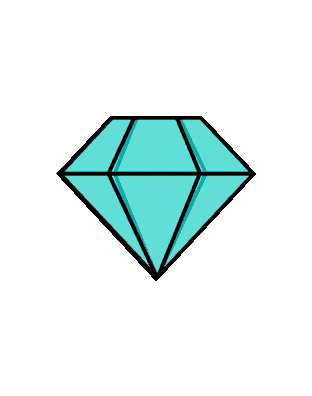OVERVIEW
By probing what type of ring is desired and then facilitating collaboration between customer and jeweler, Engager Rings crafts beautiful and fully personalized rings.
ROLE
UX designer
UI designer
DURATION
The goal of this project was to design an MVP for the Engager Rings desktop site.
4 weeks
The Problem

Like the diamonds in our client’s products, our challenge was multifaceted.
We needed to educate the user on Engager’s unique business model, guide the user through a questionnaire, direct the user to pay a deposit, facilitate communication between customer and jeweler, and allow the user to ultimately purchase their ring. To support these user flows, we also needed to create an attractive, optimized interface.
PROBLEM STATEMENT
Millennials looking to delight their intended with a one-of-a-kind engagement ring need a platform branded to inspire trust and credibility in order to feel comfortable making such an important purchase.
Research
To familiarize ourselves with the domain, we conducted a competitive analysis on other companies offering customized engagement rings.
Because of Engager's unique business model—which included questionnaire, customization, and deposit flows—we also researched websites outside of our domain that relied on similar design patterns.

Competitive and comparative analysis to identify branding opportunities and UX patterns
Insight
Our research revealed that the competition offered a fundamentally more shallow customization experience, only allowing users to select factory made bands. This insight informed everything about our design to come.
CREATING A PRODUCT EXPERIENCE
Unlike our competitors, Engager Rings was not an e-commerce experience. It was a product experience, and the look and feel of the website should reflect the delicate craftsmanship of the product and the time and care put into designing it.
BUILDING A DESIGN SYSTEM
We created three distinct visual concepts for Engager Rings and conducted desirability testing, collecting data on emotional response and product-reaction words. We then presented the test results to our client, who elected to move forward with the below style.

DESIGNER INSPIRED
This look, inspired by luxury brands, incorporates negative space, bold photography, and a minimal color palette to let the products shine.
Our "designer" style tile
According to our testers, these elements created an elegant, refined feel—one that mirrored the product. We set out applying this style to our wireframes and building out our first high-fidelity prototype.
CHARTING THE USER'S JOURNEY
We created two user flow diagrams to articulate and refine the customer journey. Because of our accelerated timeline—3 weeks to design plus 1 week for the handoff—these diagrams served as instrumental guides; we made wireframes only for key screens.
Ideation
Testing our Prototype
In our first round of hi-fidelity testing, our design direction received tremendous validation.
When asked to describe the look and feel of the interface, users chose adjectives closely related to those we preselected: elegant, luxurious, and minimal.

The team synthesizing user feedback
Additionally, we identified a pattern in the feedback regarding high-level areas for improvement. We focused our subsequent and final design sprint on the following:
CREATING OPPORTUNITIES FOR EDUCATION
Users required a better mental model of Engager Ring’s unique customization process and how the deposit fit in to it.
REFINING THE DASHBOARD
Users had trouble discovering some of the options the dashboard offered, including where to purchase the finalized ring.
The Solution
Our focus redefined, we approached the final prototype with the goal of guiding the user through the workflow. Central to our design were 3 key sections: onboarding, the questionnaire, and the dashboard.
ONBOARDING
In addition to a “learn more” section and several success screens leveraged to further educate users, we included an onboarding flow to set expectations and ensure multiple avenues for user education.

QUESTIONNAIRE
The questionnaire compiles basic user requirements (like ring size) as well as specific asks (like incorporating nature into the design). Automating this step rather than using a jeweler also cuts costs for our client.

DASHBOARD
When building the final dashboard, we focused on providing clear labeling and enhancing discoverability, allowing for intuitive access to key features like viewing current and previous ring designs and talking to Engager’s design team.


Handoff
My team spent the last week of the project assembling materials for handoff to the development team.
These included annotated wireframes, image assets, a design system in Zeplin, and a list of future recommendations and areas that necessitate additional research.

Zeplin styleguide
ANNOTATED WIREFRAMES
I annotated our high-fidelity wireframes in order to make the how and why behind certain functions as clear as possible for our client and his engineering team. These annotations also serve as an assurance to our client that his business goals were being addressed.

Success screen annotations
Walk-Through
Measuring Success
As if in direct response to our problem statement, one user offered the following remark concerning our prototype:
“Online ring shopping isn’t traditional, but this makes it feel like you’re going to the store. It makes you feel comfortable with buying something online for thousands of dollars.”
4.7/5
average user score on ease of use.
4.5/5
average user score on look and feel.
100%
of users completed all tasks successfully.
Takeaways
Creating a platform for Engager Rings was an exercise in time management, collaboration, and systematic thinking. The challenge was as difficult as it was invaluable—and my abilities improved tremendously for it.
Because of our shortened timeframe, we had to rapidly conceptualize, ideate, and produce. This necessitated strong organization, and we placed major emphasis on scheduling user tests early and often. To ensure client buy-in, I also led weekly presentations on my team’s progress, ensuring at every step of the project that business, engineering, and design goals were aligned.
I’m excited to see the final product, which is currently under development!

